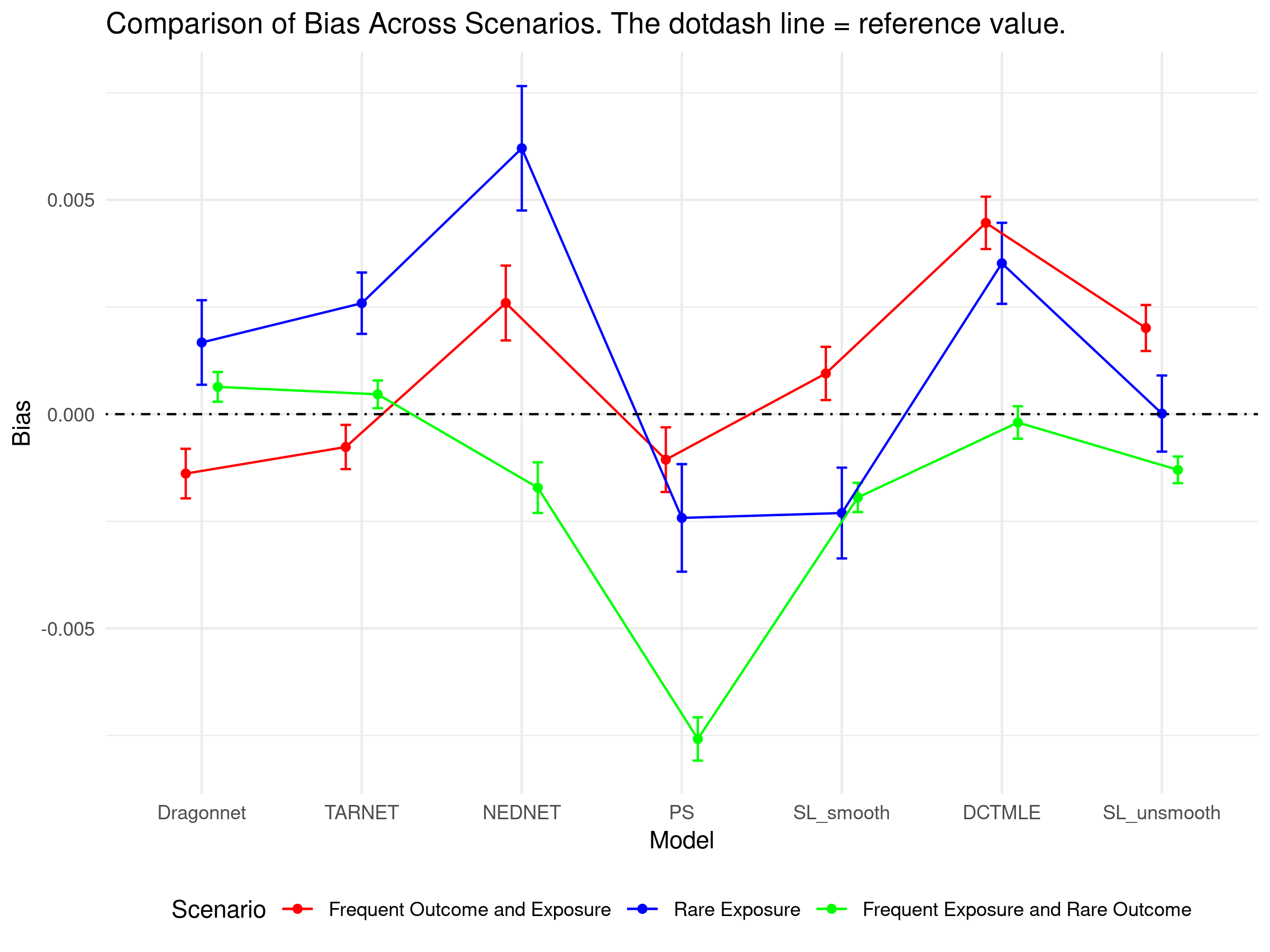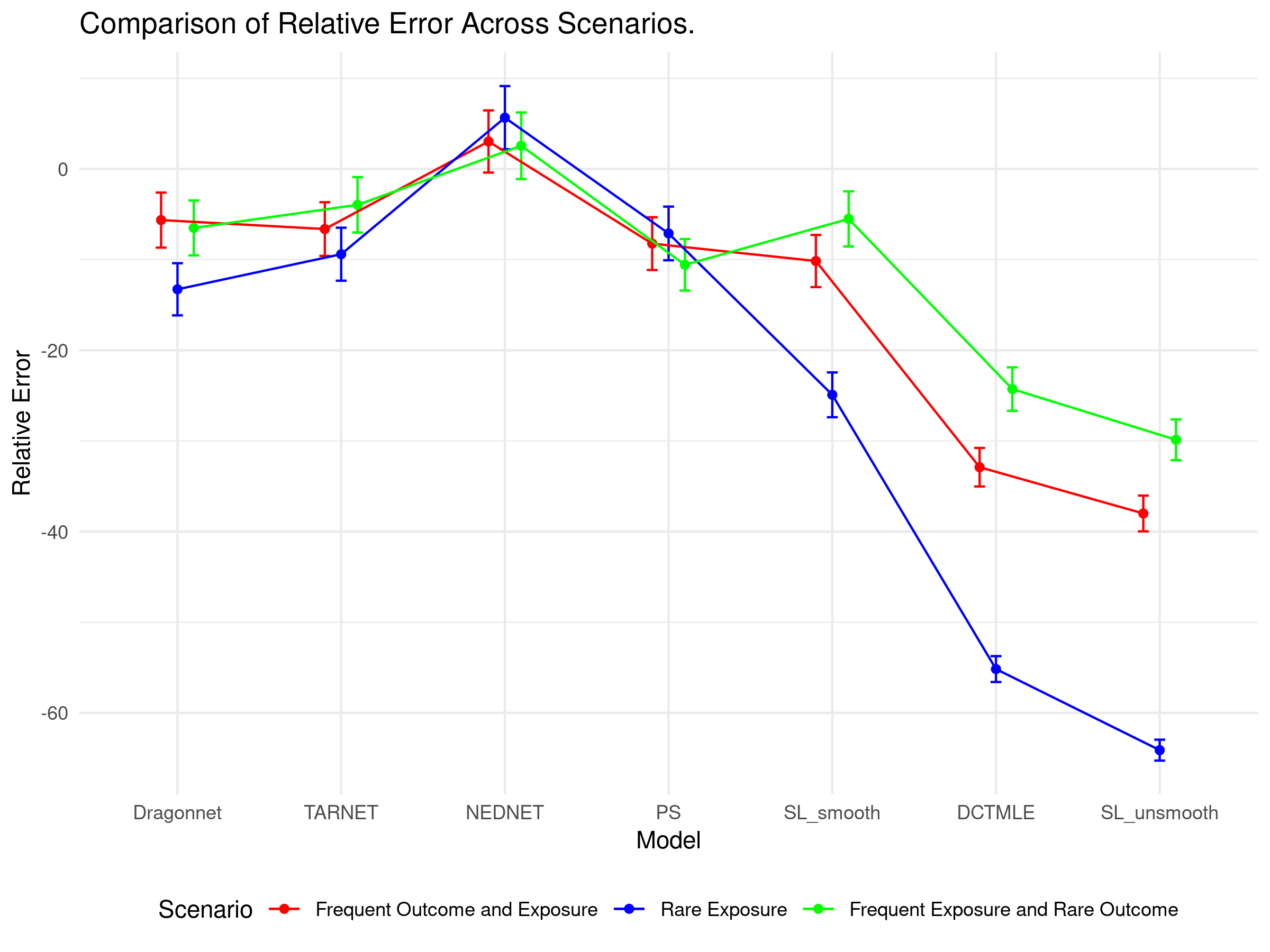
20 Deep Learning
Recent work extends traditional hdPS analyses by introducing and explaining neural representation learning methods for causal inference in observational studies. It focuses on NHANES data (2013–2018) and highlights how recent innovations in machine learning can address residual confounding and model misspecification challenges commonly encountered in high-dimensional data settings.
Based on recent work by Karim & Wang (2025).
20.1 Plasmode Simulation
| Simulation Element | Description |
|---|---|
| Source Dataset | NHANES 2013–2018 |
| Simulation Framework | Plasmode simulation preserving empirical covariate and exposure distributions |
| Simulated Sample Size | 3,000 participants per iteration |
| Iterations | 500 replicates |
| Prevalence Scenarios | 1. Frequent exposure & frequent outcome 2. Rare exposure & frequent outcome 3. Frequent exposure & rare outcome |
| True Effect | OR = 1 (null); RD = 0 |
| Outcome Generation | Logistic regression model with: - Nonlinear transformations (log, poly) - Interactions - Proxy-derived comorbidity index |
| Confounding Simulation | Unmeasured confounding mimicked using high-dimensional proxy variables |
20.2 Estimators Compared
| Method | Core Idea | Key Features | Use of Propensity Score | Optimization & Regularization |
|---|---|---|---|---|
| PSW (hdPS) | Baseline method using logistic regression on investigator and proxy covariates | High-dimensional covariates selected via hdPS | Explicitly modeled via logistic regression | None |
| TMLE (SL Smooth) (Balzer and Westling 2021) | Semiparametric estimator using Super Learner | Combines outcome and treatment models; uses smooth learners (logistic regression, LASSO, MARS) | Explicitly modeled and used for targeting | Super Learner; Donsker-compliant learners |
| TMLE (SL Unsmooth) | More flexible TMLE with XGBoost in Super Learner | Allows complex nonlinearities; lower variance reliability in small samples | Explicitly modeled and used for targeting | Super Learner including unsmooth learners (e.g., XGBoost) |
| DCTMLE (Zivich and Breskin 2021) | TMLE with double cross-fitting | Reduces overfitting in TMLE with flexible learners | Explicitly modeled and used for targeting | Double cross-fitting for robustness |
| TARNET (Shalit, Johansson, and Sontag 2017) | Neural net with treatment-agnostic shared representation | Two heads for outcome under treatment/control; most precise in frequent exposure/outcome | Not used explicitly | Targeted regularization; Adam + SGD with early stopping |
| Dragonnet (Shi, Blei, and Veitch 2019) | Neural net that jointly models outcomes and propensity score | Adds third head for PS; enforces balance and semiparametric alignment | Modeled as an explicit third output | Targeted regularization; multitask learning |
| NEDnet (Shi, Blei, and Veitch 2019) | Sequential neural network for treatment then outcome | Stage 1: predict treatment; Stage 2: freeze representation and predict outcomes | Modeled separately in Stage 1 | Targeted regularization; two-stage optimization |
20.3 Simulation Results

Results are fully accessible via a Shiny app:
👉 Interactive Causal Benchmark App
Explore bias, SEs, and coverage metrics across methods and simulation conditions.
20.4 Conclusion
- PSW remains an interpretable benchmark
- TMLE and neural methods extend this framework by improving bias-variance trade-offs and enabling better performance in complex settings
- Among deep learning methods, Dragonnet offers the best average trade-off; NEDnet excels in coverage but is computationally heavy; TARNET offers precision
- These methods are particularly useful when dealing with residual confounding, nonlinear effects, and proxy variable structures